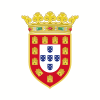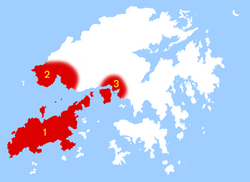You can help expand this article with text translated from the corresponding article in Chinese. (May 2020) Click for important translation instructions.
|
| Tamão 屯門 | |
|---|---|
| Trade settlement | |
 Imagined scenes of Battle of Tunmen Imagined scenes of Battle of Tunmen | |
 Flag Flag Coat of arms Coat of arms | |
 Possible extent of Portuguese settlement (1518–1521) Possible extent of Portuguese settlement (1518–1521) | |
| Country | Portuguese Empire |
| Established | 1514 |
| Battle of Tunmen | 1521 |
| Founded by | Jorge Álvares |
| |
| Tamão | |
|---|---|
| Traditional Chinese | 屯門 |
| Simplified Chinese | 屯门 |
| Hanyu Pinyin | Tún Mén |
| Pha̍k-fa-sṳ | Thûn mùn |
| Yale Romanization | Tyùhn mùhn |
| Jyutping | Tyun mun |
| Tunmen Inlet | |
| Traditional Chinese | 屯門澳 |
| Simplified Chinese | 屯门澳 |
| Hanyu Pinyin | Tún Mén Ào |
| Pha̍k-fa-sṳ | Thûn mùn àu |
| Yale Romanization | Tyùhn mùhn ou |
| Jyutping | Tyun mun ou |
Tamão (Chinese: 屯門) was a trade settlement set up by the Portuguese on an island in the Pearl River Delta, China. This was the first time Europeans reached China via the sea route around the Cape of Good Hope. The settlement lasted from 1514 to 1521, when the Portuguese were expelled by the Ming dynasty navy.
Location
In May 1513, the Portuguese explorer Jorge Álvares arrived on the Chinese coast at an island in the Pearl River Delta, which they called "Tamão", which is understood to be a corruption of "Tyunmun" (屯門), the name for what is now the western Hong Kong and Shenzhen area. Chinese sources state that the Portuguese settled around the Tunmen Inlet (屯門澳), but the current whereabouts of the Tyunmun Inlet is unknown, so the precise location of the Portuguese settlement remains a matter of debate among historians.
Rendered in Chinese, the name is identical to the Tuen Mun district in present-day Hong Kong. This leads some researchers to link the Tyunmun of Ming times to Tuen Mun in the New Territories of Hong Kong. "Tyunmun Inlet" would then refer to one of two bays around Tuen Mun: Castle Peak Bay, next to the current Tuen Mun New Town; or Deep Bay between the New Territories and Nantou in present-day Shenzhen, where a Ming coastal defense force was stationed.
One source specifically states that the settlement was at the "bay of Tyunmun ... now called Castle Peak". This merely adds to the confusion since the description in Portuguese sources clearly stated that Tamão was an island. As Tuen Mun is not an island, some researchers have proposed that Tamão may actually refer to one of the nearby islands. Nei Lingding Island has been identified by J. M. Braga to be the Tamão of the Portuguese sources, and is widely followed by Western scholarship; however, recent Chinese scholarship has argued that this identification is insufficiently supported by historical evidence, and suggests a number of other potential islands, such as the nearby Chek Lap Kok or the larger Lantau Island.
In 1521, the settlement was abandoned after the Battle of Tunmen with the Chinese navy; the Portuguese gathered in Malacca in Malaysia.
According to sources quoted by National Geographic, "Macau may never have existed if not for Tamão" where the Portuguese learned valuable lessons about "how China, the Pearl River Delta, and the South China Sea worked".
See also
References
- "Construction of Lung Kwu Chau Jetty – Cultural Heritage Impact Assessment". epd.gov.hk.
- Porter, Jonathan (1996). Macau, the Imaginary City: Culture and Society, 1557 to the Present. Westview Press. ISBN 0813328365.
- Braga, J. M. (1956). China Landfall 1513, Jorge Alvares Voyage to China. Macau: Imprensa Nacional. OCLC 10673337..
- ^ O'Connell, Ronan (16 March 2021). "The Long Lost City of Tamão is Hiding in Plain Sight". National Geographic. Archived from the original on 15 March 2021. Retrieved 16 March 2021.
- Lau, Chi-pang 劉智鵬; Liu, Shuyong 劉蜀永 (2012). 屯門: 香港地區史研究之四 [History of Tuen Mun] (in Chinese). Hong Kong: Sanlian shudian. p. 35. ISBN 9789620431470.
- Cremer, Rolph (1987). Macau City of Commerce and Culture. Vol. 1. Detroit: University of Michigan. p. 9. ISBN 9623080026.
- Jin, Guoping 金國平 (2000). Xīlì dōngjiān: Zhōng Pú zǎoqí jiēchù zhuīxī 西力東漸 : 中葡早期接觸追昔 [West to the East: China and Portugal's early contacts and reminiscences] (PDF) (in Chinese). Aomen: Aomen jijin hui. pp. 21–42. ISBN 99937-1-007-5.